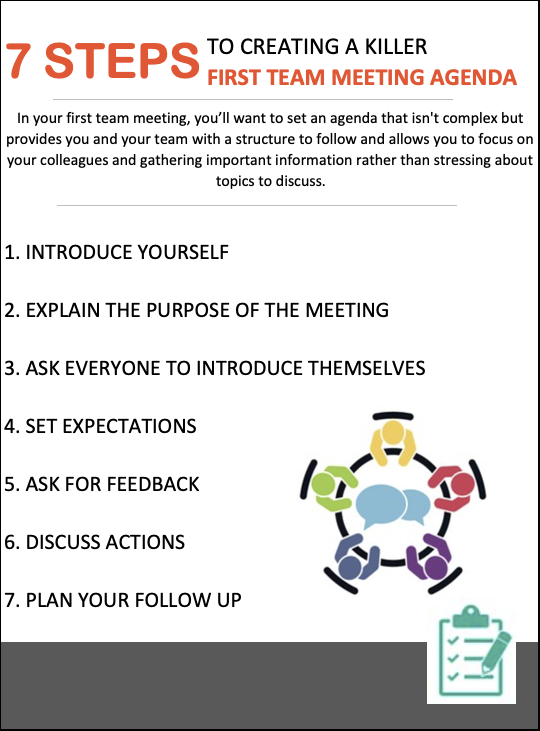
In your first team meeting, you’ll want to set an agenda that isn’t complex but provides you and your team with a structure to follow and allows you to focus on your colleagues and gathering important information rather than stressing about topics to discuss.
In this article, I’ll be exploring the first team meeting agenda. We’ll be exploring:
- Example first team meeting agenda
- Introduce yourself
- Explain purpose of the meeting
- Team Introductions
- Set Expectations
- Ask for feedback
- Review Actions
- Agree next meeting
- Why do you need a first team meeting
- The importance of the agenda
- How to prepare for your first team meeting
- Make your first team meeting successful.
Example first team meeting agenda

The first time you get your team together, you might be wondering whether you need an agenda at all, let alone what might need to go in it. This is undoubtedly an option in that you can merely gather your team together and have a chat. The downside to this approach is that you might miss crucial discussion points and fail to make the right initial impression.
As a result, you need an agenda, one that’s going to get you acclimatized to your team and them to you as swiftly as possible.
Just before we discuss some example agenda points, we’ll look at three elements to consider that can shape your meeting structure:
- Who will have most of the dialogue – Will it be you or your colleagues? Understanding this can set the framework of your agenda, i.e., Will it be you merely passing information on, or will you be seeking information from the team?
- What style of meeting do you want? Will it be formal or relaxed? (A word of caution here is that being too strict and stern in your first meeting can turn your colleagues off)
- Do you want to obtain specific information from your team? If so, you can use the agenda to help obtain it.
Let us now look at some example agenda points which should be included in your first meeting.
1/ Introduce yourself
Look to include some background information about yourself, i.e., what role were you previously doing, how long have you been in the industry, etc. Look to keep this part short; you won’t want to use the entire meeting to talk about yourself!
2/ Explain the purpose of the meeting
Explain why you have gathered everyone together and what you hope to achieve. This may just be “I wanted to get to know you all better as we will be working together.” or it could be to look at specifics of the department.
3/ Team Introductions
You might want each team member to:
- Explain their roles
- Say how long they’ve been with the company
- Explain what motivates them about their job
- Identify the positives and negatives about working for the company
4/ Set expectations
Setting expectations may seem difficult, you don’t want to come across too stern, but you do want to say how you want things done, consider some of the following points:
- What expectations that you have from the team
- What values will you be looking for the team to demonstrate
- How will the team approach tasks?
- How will communication work?
- What do you expect when something goes wrong?
5/ Ask for feedback
Give everyone a chance to have a say. This is all about asking the right questions. This is one of the most important parts of the meeting, as probing your new team can help uncover what is happening in your department.
- How are things going?
- What challenges do they face in getting the job done?
- Make it clear that this is not the only time where they can engage in dialogue. Ensure that you state that if they’ve got questions that you will make yourself available, and you’ll be open for further discussion
- Are there any improvement opportunities?
- How do they interact with other departments?
- Is communication effective?
6/ Discuss the immediate actions for the team
Try and obtain the status of the team through the actions it’s carrying out.
- Is there an existing actions list?
- What problems need solving?
- Are there departmental targets to be achieved? How will they be achieved?
- Are there actions that require immediate attention?
7/ Set a date and time for your next session
Communication with your team should not be a one-off. Finish your meeting by agreeing on when you will next meet as a group. Be sure to capture any actions that came out of the first meeting so that you can review progress and discuss them at the next one.
Why do you need a first team meeting
Now we’ve given some ideas around what to include, let’s now discuss some of the other reasons why you need to meet.
.
There are several basic principles that the meeting can facilitate:
1/ To start building relationships
2/ To facilitate communication in both directions
3/ To assess strengths & weaknesses of the team
4/ To help you establish your leadership position
5/ To help build trust
The importance of the agenda
Let’s return to the question of whether you should use an agenda.
Personally, having a meeting that is free form and without structure is one where you’re asking for trouble.
With no agenda, you run the risk of missing things, spending too much time on one topic, and appearing disorganized.
Agenda are important as they:
- They set expectations
- It promotes a good first impression
- It helps people prepare
- It’s set an order for things which will be discussed
- It helps you allocate time for each topic
- It helps tell people when the meeting is finished
How to prepare for your first team meeting
Once you have your agenda, you will need to prepare for the meeting itself. This usually involves several actions that you will need to complete ahead of time, these typically include:
- Choose a meeting location.
- Inviting the team
- Sending out the agenda so people can prepare
- Selecting the appropriate format of meeting (i.e., face to face/ video conference),
- Coming up with a meeting plan if your team is too large to see in one go
- Setting your goals for the meeting
- Considering the style of meeting you want (i.e., formal or informal)
- Thinking about the impression you want your team to take away with them.
Make your first team meeting successful

Finally, let’s consider the steps you need to take in order to make your meeting a success. These should include:
- Adequately prepare
- Make your primary objective about building relationships with your team
- Develop an agenda and share it with the team
- Relax and be patient
- Encourage feedback
- Use appropriate language
- Give everyone enough time to speak
- Take notes!
Summary
Your first team meeting can be a daunting situation if you’re not used to them.
Now that we discussed the first team meeting agenda, you can see that perhaps it’s not as daunting as you first anticipated. With a bit of structure (your agenda) and some up-front planning, it can be successful.
What’s your experience of first team meetings? How have you made it work? What tips can you share in honing your agenda? What challenges did you face, and how did you get around them?
As ever, we’d love to hear from you; you can reach us on Twitter (@sanbustrain) or via the comments section below; we’d love for you to share your experiences.
This article is part of our Management & Leadership Guide.